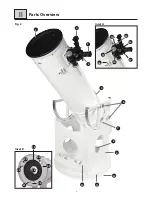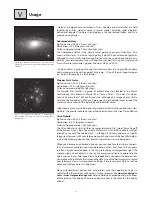
- 12 -
V
Observation suggestions
The Moon:
Diameter: 3,476 km
Distance: Approximately 384,401 km
The Moon is the Earth’s only natural satellite, and it is the second brightest object in
the sky (after the Sun). Although it is our closest neighbor, a lot of people have never
really taken a good long like at the Moon. With your telescope, you should be able
to see the intricacies of the lunar terrain — including lunar maria, which appear as
vast dark plains, craters and rilles. The best views will be found along the terminator,
which is the edge where the visible and cloaked portions of the Moon meet.
Planets
The planets are continuously changing their position in the sky, so it may help to
consult online resources to determine the correct place to look on any given night.
The following planets are especially suited for observations with a Dobsonian
telescope.
Venus
Venus is the third brightest object in the night sky, which makes it an ideal observing
target. The diameter of Venus is about 9/10th the diameter of the Earth. Viewing
Venus at different times in its orbit will reveal different phases (crescent, half and
full) much like the phases of our Moon. The planetary disc of Venus appears white
because the sunlight is reflected by a compact layer of clouds that covers all surface
details.
Mars
The diameter of Mars is about half that of the Earth's diameter. It will appear as a
red-orange disk, which may exhibit small white patches near the polar regions.
Observing Mars when it is closest to the Earth will show even more details, so it is a
good idea to consult online resources to determine when those dates might occur.
Jupiter
Jupiter is the biggest planet in our solar system and is the fourth brightest object in
the night sky. The equatorial diameter of this gas giant is 11 times bigger than that
of the Earth. Through the telescope, you should be able to see the cloud bands in
the atmosphere of Jupiter and the Great Red Spot. Even with low magnification, you
will be able to see the four Galilean moons — Io, Ganymede, Europa and Callisto —
as they march across the face of Jupiter. You might also be able to pick out some of
the many smaller moons of Jupiter.
Saturn
Saturn is a dynamic sight when viewed through a telescope. It will appear as a
round disc surround by its distinct ring structure. The rings of Saturn mainly consist
of billions of icy particles ranging from dust up to chunks that size of a house.
The Cassini division, which is a large gap in the rings, might be visible from your
telescope. You will also be able to see the largest of Saturn's moons — Titan — and
possibly others.
Deep sky objects
There are several types of deep sky objects that make excellent observing targets.
To locate specific targets it is important to have a star chart and be familiar with the
constellations. The following are types of deep sky objects that you can observe:
• Stars are giant objects that mainly consist of gas. They radiate energy and shine
because of nuclear fusion going on in their core. Due to the fact that star are
extremely far away, they appear as points of light both to the unaided eye and in
telescopes. However, with a telescope, you might be able to view separate members
of binary or multi-star systems.
Fig. 16: Craters of the moon are excellent targets to
observe even for beginners.
Fig. 17: Planet Venus in its thin crescent phase
Fig. 18: Jupiter's four largest moons can be observed in a
different position every night.
Fig. 19: Saturn is perhaps the most unforgettable sight to
see in a telescope.
Usage
Summary of Contents for Explore FirstLight 10" f/5 Dobsonian
Page 19: ...19...





























